Bluebeard’s Castle
Béla Bartók, Composer; Béla Balás, Original Hungarian Libretto
English Translation by Steven White and Joseph Marcheso
Opera San Jose
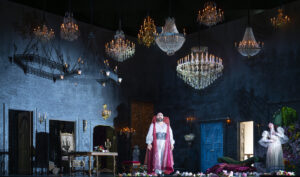
An immense, dark, dungeon-like castle with its interior dimly lit by magnificent hanging chandeliers and wall scones of flickering candles is the setting for Opera San Jose’s intriguing, beguiling, and sinister-shrouded Bluebeard’s Castle, Béla Bartók’s 1918-premiering one-act opera based on an old French folktale. The massive walls of the castle are dominated by seven closed doors of varying sizes and styles, all with a look ominous and forbidding. A narrator sets the tone for Bartók’s Symbolist work in which everything from characters and setting to words and events hint at abstract, deeper, or even psychological meanings:
“Once upon a time …
Where did this happen?
Outside or within?
Where is the stage?
Outside or within?”
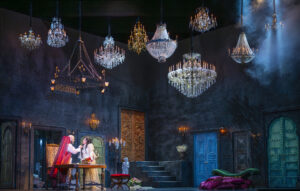
The master of the castle, Lord Bluebeard, is welcoming home his bride, Judith, who runs down the aisle of the magnificent California Theatre — itself with castle dimensions and interior — still in her wedding dress. With expressions of excitement and anticipation but with a noticeable moment of extreme anxiety before finally climbing the stairs, she joins her groom in his high-necked cape of red. With a powerful baritone that elicits mystery and foreboding, Zachary Nelson’s Bluebeard greets her, “Don’t you hear the alarm’s ringing? Your mother is dressed for mourning.” When he asks in deep tones the first of what will be many times, “You’re certain? Are you frightened?” Maria Natale’s soprano answer for the newly wed Judith is “I’ll be here and forever.”
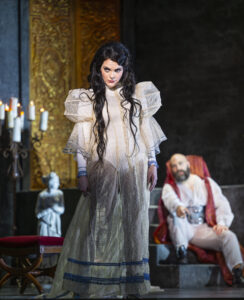
As she further intones in notes measured and yet curious, “Dark and gloomy is your castle,” Judith mounts with spread legs her waiting groom as he sits at his great desk. Intermingled between highly erotic glances and sensuous caresses, Judith assures repeatedly, “Darling Bluebeard, I shall brighten this gloomy castle … Let your castle shine in glory.” Bluebeard’s reply in echoing baritone tones should have given her more pause than it does: “There is no glory within this castle.”
Easy it is at this point to wonder if Bela Lugosi has resurrected in the form of this handsome but devilish appearing Lord Bluebeard; and in her flimsy, flowing gown that reveals bare legs and skimpy, tight panties (Caitlin Cisek, costume designer), there is more than a little resemblance to one of Dracula’s brides. The shadowy, eerie atmosphere; those seven, fortress-like doors; and a haunting sighing that Judith and we repeatedly hear all add to the sense of doom that is surely to come.
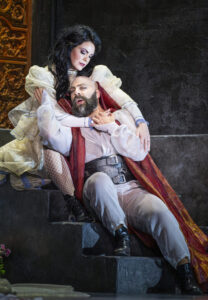
Between moments of slow, purposefully arousing strokes of her outstretched hands and a body that dramatically poses in seductive stances, Judith sings imploring requests of “open, open,” becoming evermore commanding in volume and tone. Taking a bite from the reddest of apples and looking at her with an unsettling gaze, Bluebeard hands her the first door’s key and takes yet another bite as the sighs of the walls moan when she opens the door. As she stares at walls stained in blood and full of the instruments of torture, Bluebeard warns, “Careful, careful of my castle.” At the same time, the orchestra’s woodwinds and xylophone burst into shrill, ever-increasing intensity, soon enveloped with the sounds of violins.
Though she wipes her hands of the blood from within, Judith is not satisfied with only one door opened. Her entreaties intensify as Maria Natale’s vocals reach for ever-higher realms, sometimes approaching near screeches as more is revealed and more is desired. Doors open to new discoveries both horrendous and beautiful; all are accompanied with the red of blood.

Although Maria Natale and Zachary Nelson are both quite noteworthy as vocalists and especially as stage actors, the libretto that they are provided is actually quite repetitive and a bit on the bland side. Missing are the arias and memorable duets that opera principals usually are afforded. But with a full orchestra of forty-plus, Bartók’s opera is one in which the played score becomes the third and in many ways, the more important character. The true musical highlight of the evening is the revelations of each door’s contents as so wonderfully and gloriously illustrated through Bartók’s Hungarian-inspired score and so ably played by the San Jose Opera’s orchestra under the direction of Joseph Marcheso.
A brassy trumpet heralds Door Two; flute chords and soft trumpet, Door Three; impressionistic strings in intimate communication with a solo French horn, Door Four. As Door Five is opened to reveal the kingdom of Lord Bluebeard, the full orchestra soars along with the rich, deep tones of pipe organ and the triumphant beats of kettle drum. An acute and fierce argument sung between bride and groom over whether the final two doors should remain locked or be opened is made more fiery by the frenzied intensity of the orchestra while the tears and shock to come of those two final doors is reflected in music often surreal as it cries its own tearful notes. The shifting moods, the revelations that can be equated on many different psychological levels, the beauty and the horror of the doors all become a wonderful landscape of orchestral majesty.
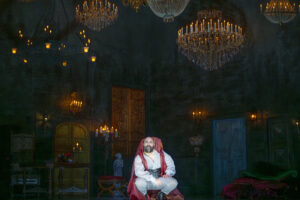
In creating the movie-like setting of the castle, Steven C. Kemp has given Opera San Jose regulars a trove of treasures to find. Doors, chandeliers, and many properties come from past productions like The Marriage of Figaro, Tosca, Il Segreto, and Cinderella. As each door is opened, not only are there set design wonders to behold, but the lighting mastery of Michael Clark swings into full play with different doors flowing with various, telling arrays of color. Shadows play a big part in the evening’s mood swings and increasing disquietude, showing more of the lighting design’s important role in the storytelling of the opera.
Though the likelihood that many in the audience have ever seen this rarely produced two-hander, one-act opera, for any one who arrives having read the synopsis, Director Shawna Lucey has a plot twist and treat in store that adds new meaning with current significance. Without one word added to Steven White and Joseph Marcheso’s English translation of Béla Balázs’ original libretto, an entire new chapter has been added to provide Bluebeard’s Castle with an ending none of us will forget.
An opera quite unlike one that many audience members have probably seen in the past, Opera San Jose’s evocative Bluebeard’s Castle is a visual wonder and a fascinating unveiling of surprises, with dark and ominous threads leading to an unexpected climax. It is important, however, that any potential attendee realize that one of the major aspects that sets this opera apart from the norm is that its length is a mere seventy minutes. In my book, such a short production raises questions whether the price of ticket, parking, and possibly dinner makes the evening worthwhile. But if that is not an issue or problem, then a visit to explore Bluebeard’s Castle is an evening long to be remembered.
Rating: 3.5 E
Bluebeard’s Castle continues through March 2, 2025 in a seventy-minute production by Opera San Jose at the California Theatre, 345 1st Street, San Jose, CA. Tickets are available online at www.operasj.org or by phone at 408-437-4450, 10 a.m. – 4 p.m., Monday – Friday.
Photo Credits: David Allen
